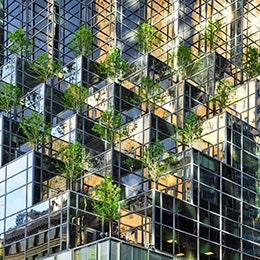Real estate: unlocking enhanced returns for DC members
It hasn’t always been easy for UK DC pension schemes to invest in illiquids. But in today’s environment, it is more important than ever. Kate Dwyer and Simon Redman outline how Invesco Real Estate can help.
My name is Kate Dwyer, Head of UK Distribution at Invesco, and today we'll be diving into a topic that is increasingly capturing the attention of investment professionals.
Let's start by acknowledging the shifting landscape of pension fund investment in the UK. Defined Contribution pension funds play an increasingly pivotal role in securing the financial future of individuals. At Invesco we are committed to helping pension members attain the best outcomes they can. Focusing solely on traditional assets like equity and fixed income, does not, in our view optimise these outcomes. DC investors are now exploring alternative private market investments to diversify their portfolios and generate attractive risk-adjusted returns.
Whilst there are a few alternatives, global real estate, at around £31tn USD, is by far the largest private market and one that is familiar to many - making it a natural first step. To give this some context, the real estate investible universe is over six times larger than infrastructure and private credit combined.
But why should DC investors consider allocating part of their portfolios to this asset class at all?
In summary, global real estate has delivered risk adjusted returns 50% higher than global equities and 100% higher than fixed income over the last ten years.
Given this compelling backdrop, I’m delighted to introduce Invesco’s Global Direct Property Fund: a portfolio built specifically for Defined Contribution pension funds, allowing them to bring the benefits of global, direct real estate to their scheme members.
Here to tell us more about it, and the investment approach being taken, is Simon Redman, Managing Director and head of DC and Wealth at Invesco Real estate.
Simon
Thank you, Kate, the benefits in terms of improving investment outcomes by both increasing returns and reducing risk are pretty clear, and it is why many global, sophisticated institutional investors typically commit 10-15% of their portfolio and some as high as 25% to direct global real estate investments. I should at this point stress that I am talking about direct global, unlisted real estate – physical buildings in other words – and not listed REITS. The challenge for many DC investors is often not the idea but the execution. How can DC members make this sort of investment into physical buildings around the world? Something that, at Invesco, we have worked hard to solve in a practical way.
Invesco’s Global Direct Property Fund, leverages not only the deep expertise of our on-the-ground teams in 21 offices and 16 countries to provide scheme members with unprecedented access to some of what I believe to be the most interesting real estate around the world; but we have also harnessed our experience of UK DC members to create a fund that is easily accessible for members via DC platforms in a cost effective way and one designed to avoid many of the gating challenges UK only property funds have suffered from. We do all of this whilst taking an active approach to sustainability.
Over the next five minutes I will talk through some of these opportunities, and explain how we, at Invesco, tackle global investing.
Before that, I want to talk a little about the potential for attractive long-term returns that global direct real estate offers. Historically, real estate has been recognized as a valuable source of income and capital growth and by focusing on developed markets worldwide, gives exposure to a diverse range of properties across different geographies and sectors – many of which are simply unavailable in the UK.
Whilst global real estate is the largest private markets asset class the UK represents less than 5% of it. It is natural therefore to take a global approach, taking advantage of the 95% that the rest of the world offers. By doing this we can mitigate the risk associated with local market fluctuations and provide a stable income stream, thus helping to meet the long-term pension fund obligations. A very simple and illustrative example of “why global” is that whilst BREXIT had a material impact on the UK property market, it had no impact on any other real estate market worldwide.
Secondly, real estate income has historically demonstrated a positive correlation with inflation as rental income tends to rise in tandem with inflationary pressures – many continental European leases for example are directly linked to inflation. This characteristic can be particularly beneficial for members seeking to protect the purchasing power of their assets and ensure they receive adequate income in the face of rising living costs.
Furthermore, global real estate offers compelling diversification benefits. Unlike publicly traded fixed income and equities, including REITs, which are subject to daily market volatility, direct real estate investments are much more stable. This can help reduce the sensitivity of pension fund returns to short term market fluctuations. It is why the risk adjusted returns are 100% higher than bonds and 50% higher than equities.
So now onto our approach to investing in global real estate. I’ve already hinted at the idea that global real estate can provide an avenue for accessing unique investment opportunities that may not be readily available in public markets. Investors can gain exposure to a wide range of property types, including commercial, residential, industrial, and healthcare assets, thus allowing them to capitalize on the potential for enhanced risk-adjusted returns by tapping into real estate growth sectors linked to long term secular trends.
The way we think about this is simply that real estate houses the economy. It may be the oldest asset class, but it is always relevant – we always need somewhere to Connect, Live, Innovate and Consume.
Consumption, is where we look at how wealth is spent – that maybe retail either physical or on-line, but let’s not forget travel, hotels or healthcare.
We need places to Live, but where and how we actually live is driven by demographic and economic trends.
Innovation helps drive global growth, from the industrial revolution in the past, to technology and life sciences today - it all needs to be housed somewhere.
And lastly, most economic growth does not, of course, come solely from innovation but is through Connections be that services, technology or manufacturing from warehouses, data centres or offices… we all need to connect and again it has to happen somewhere.
All these activities require real estate.
Demographics around the world are also different. The profile in Europe versus Asia versus the US is not the same.
These trends and differences around the world create different opportunities and is why, we feel, having the ability to invest globally simply offers us more investment choice. We can pick the best of a larger pool of opportunities.
Another important secular trend is a welcome increased focus on sustainability. Real Estate accounts for 39% of CO2 emissions worldwide. By directly owning and managing properties we can actively reduce CO2 not only emissions but also energy and water usage and waste. In fact, we are currently ahead of some of our 2030 goals. Importantly, this does not have to result in us sacrificing financial returns to do so; we can even increase them.
We believe that, by taking a deliberate and disciplined approach to ESG, we can successfully balance our social and environmental responsibilities, meet the needs of our clients, fulfil our fiduciary responsibilities and drive strong investment performance.
So, I have talked a bit about the theory, but let’s look at some of the investments in practice:
Asia’s rapid urbanization will see over 50% of the world’s population residing in Asia by 2030.
Asia has higher living densities and generally smaller living space that North America or Europe.
This increased demand for residential space across major Asian cities combined with limited supply creates a potentially interesting real estate investment opportunity.
Late last year we invested in this portfolio of fifteen state of the art, newly built apartment buildings located in Tokyo, Osaka, Nagoya and Fukuoka – the four largest cities in Japan. The portfolio, comprising over twelve hundred individual apartments exemplifies how we put investment theory into practice by investing in cities where there is a multi-decade secular trend of urban city centre migration and falling vacancies.
Urbanisation not only creates a residential opportunity, but there will also be a need for more offices, retail and more niche sectors like cold storage to satisfy this expanding population.
So, staying with demographic influences, but looking at how they impact a different sector and region.
Health care spending in the US represents nearly 18% of GDP, and has been growing at more than 5% per year for the last 20 years.
Over the next 20 years, the number of Americans that are aged over 75 will expand by over than 20 million, more than doubling in size.
This age-group’s spending on health care is dramatically higher than the general population.
The combination of these demographics together with the US having a mainly privately funded healthcare system creates a real, real estate investment opportunity.
The number of privately run healthcare facilities like the two shown here, which are part of a portfolio we manage, will have to grow in order to satisfy this increasing healthcare demand.
These are just a few examples from our portfolio, and we have many others.
So, in summary, investing in global real estate offers the potential to invest in some of the most compelling sector and market combinations worldwide, in opportunities both unavailable and unaffected by negative events in the UK. We can do this whilst increasing return potential, reducing risk and with the capacity to improve the environment. Investing after we have seen interest rates peak will, we think, offer vintage year opportunities we have not seen since after the global financial crisis.
I mentioned at the beginning that Invesco is focused on improving the outcomes for DC members. To that end, the Invesco Global Direct Property Fund provides an innovative, cost effective way for DC schemes and master trusts to access direct real estate in a platform friendly way.









